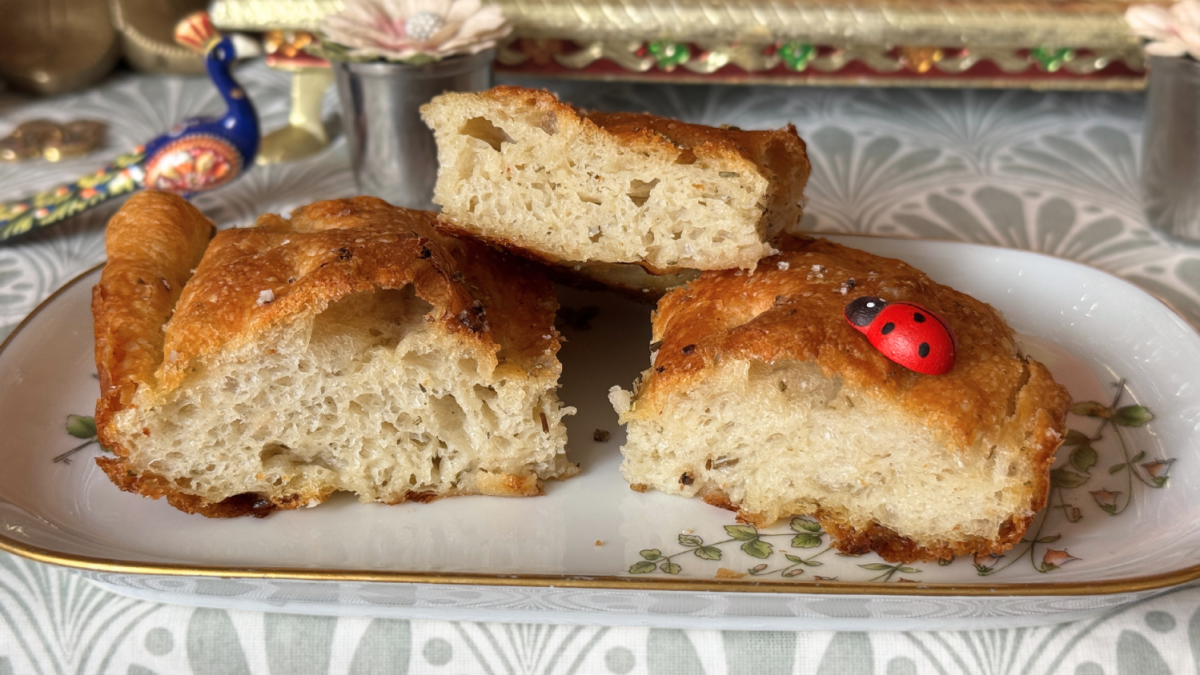High-Hydration Focaccia

High-Hydration Focaccia Recipe (80% Hydration, 4 Folds)
Total Time:
- Total (Same-Day Version): ~5-7 hours. Check the Variations and Adjustments section for faster process.
- Total (Cold Fermentation Version): ~14-26 hours
Level of Difficulty:
Intermediate – The process is simple, but handling high-hydration dough and allowing time for fermentation requires some experience and patience.
Ingredients
- 500g bread flour (high-protein, 12-14%)
- 400g water (80% hydration, lukewarm ~90°F/32°C)
- 6g instant dry yeast (~1 ½ tsp)
- 10g salt (~2 tsp)
- 20g extra virgin olive oil (~1 ½ tbsp)
- 5g honey or sugar (~1 tsp)
- 10g dry rosemary (~2 tsp), alternatively you can use 5 to 8 little branches of fresh rosemary
- Extra olive oil and flaky salt for topping
Instructions
1. Mix the Dough (No-Knead Method)
- In a large bowl, whisk together flour, yeast, and dry rosemary.
- Add salt and honey, stirring until evenly distributed.
- Add lukewarm water and mix with a spoon until fully incorporated—no need to knead. The dough will be shaggy and sticky, which is normal.
- Cover and let rest for 20 minutes before starting the folds.
2. Stretch and Fold (Gluten Development - 4 Sets)
Each fold set is spaced 25 minutes apart. Keep dough covered at room temp (~72-75°F/22-24°C).
Add 20g of Evoo (extra virgin olive oil) to the bowl. Poke with your fingers the dough and see the magic happening, the dough will become soft and smooth. Distribute evenly the Evoo.
1st Fold
Lightly wet your hands with Evoo. Grab one side of the dough, stretch it up, and fold it over itself.
Rotate the bowl 90°, and repeat 3 more times.
Cover and rest for 30 minutes.
2nd Fold (25 min after the previous fold)
Repeat the same stretch-and-fold technique. Dough should feel stronger.
Cover and rest.
3rd Fold (25 min after the previous fold)
Dough should be smoother. Continue stretching and folding.
Cover and rest.
4th Fold (25 min after the previous fold)
Last set of folds. Dough should be elastic and airy.
Cover and let rise for another 1 to 2 hours, or until doubled.
3. Cold Fermentation (Optional, but Recommended for Flavor)
- Transfer dough to an oiled container.
- Refrigerate overnight (8-24 hours) for better texture and taste.
- Let it come to room temp for 2 hours before baking.
4. Shaping and Final Rise
- Generously oil a pan (9x13 inches / 23x33 cm) or baking sheet.
- Transfer dough, gently stretching it toward edges.
- Cover and let it proof for 40-60 minutes, until puffy.
5. Dimpling and Baking
- Preheat oven to 450°F (230°C).
- Prepare the brine: In a container, whisk together:
- 50ml Evoo
- 50ml water
- 1/2 tsp of salt
- Pour the brine mixture evenly over the dough, letting it flow to the edges.
- Use your fingers to create deep dimples across the surface, allowing the brine to pool in the dimples.
- Sprinkle flaky salt and dry rosemary. If you are using fresh rosemary this is the time to place your branches on top of the dough.
- Bake for 25-35 minutes, or until golden brown.
- Let cool slightly, then enjoy!
Variations and Adjustments
- Hydration Levels: Depending on the flour, you can push hydration up to 90% or even 95% for an ultra-open crumb. Stronger flours will handle higher hydration better.
- Yeast Adjustments: If you’re short on time, increase the yeast slightly to 8-10g for a quicker rise. Conversely, reduce it for a slower fermentation with more flavor.
- Fermentation Flexibility: Cold-proofing the dough for up to 48 hours deepens flavor. For same-day focaccia, let it bulk ferment for 3-4 hours at room temp instead.
Final Tips
✔ Use filtered water if possible—better fermentation.
✔ Don't rush fermentation—longer = better flavor!
✔ Experiment with herbs, olives, artichokes, or dry tomatoes as toppings.
This focaccia is super versatile—play around with hydration, proofing times, and toppings to make it your own! Let me know if you try it!
Nutritional Information (per serving, based on 12 servings):
- Calories: ~220–250 kcal
- Protein: ~6–7 g
- Carbohydrates: ~30–35 g
- Fiber: ~1–2 g
- Sugars: ~0–2 g (natural from flour)
- Fats: ~9–10 g
- Saturated Fat: ~1–1.5 g
- Omega-3 & -6: Trace amounts from EVOO
Micronutrient Highlights:
- Iron: ~1.5–2 mg (from flour, olive oil)
- Magnesium: ~3–5% of daily intake (from flour, olive oil)
- Zinc: ~5% of daily intake (from flour)
- Potassium: ~100–150 mg (from flour, olive oil)
- Folate: ~1–2% of daily intake (from flour)
Ayurvedic Profile
- Vata: 🌀 60% – The olive oil and flour provide nourishment and grounding, ideal for Vata types, while the warm, comforting texture of bread helps balance Vata’s cold, dry qualities.
-
Pitta: 🔥 40% – The olive oil and rosemary offer warmth, but the salt and richness could increase Pitta if consumed in excess, so it's best for Pitta in moderation.
-
Kapha: 🌿 55% – The dense, hearty nature of this bread makes it slightly heavy for Kapha, but the rosemary and olive oil help to stimulate digestion and provide warmth, balancing Kapha’s cold, heavy qualities.
Effect:
Grounding and soothing: This focaccia recipe offers comfort and nourishment in moderation, providing balance for the body. It helps stabilize Vata, and offers grounding for Kapha, while providing a slight energy boost to Pitta. However, due to the richness and warmth of olive oil and rosemary, it’s best enjoyed in moderation by Pitta types. A great choice for cooler months, it provides moderate warmth and richness without being too heavy.
To create a balanced meal, pair this focaccia with a nutrient-rich salad, a source of plant-based protein such as beans or lentils, and a fiber-packed side like roasted vegetables or a light soup to round out your meal with healthy fats, protein, and fiber.
Cycle Syncing Suggestion
- Luteal Phase (Inner Autumn) – Ideal: Focaccia's grounding, nourishing nature supports this phase by stabilizing energy and balancing Vata. The heavier carbs help fight fatigue and irritability, making it a great fit for comfort food cravings.
- Menstrual Phase (Inner Winter) – Ideal: The rich, comforting nature of focaccia supports energy replenishment, making it great for the Menstrual Phase. It helps restore energy and provides grounding nourishment especially if you use wholegrain flour for the focaccia.
- Follicular Phase (Spring) – Not Ideal: The heaviness and richness of focaccia might be too much during this phase, where the body benefits from lighter, fresher foods. This is the time for lighter grains, raw vegetables, and fresher foods.
- Ovulatory Phase (Summer) – Moderate Fit: While it can be enjoyed, focaccia may not be the best choice here due to its heaviness. The Ovulatory Phase benefits from lighter, cooling meals that support digestive fire and vibrant energy.
While this focaccia is perfect for your Inner Autumns and Winters, it’s always okay to enjoy it in moderation anytime you’re craving something warm and comforting. Pair it with protein like lentils, chickpeas, or seitan, and a side of roasted vegetables or a fresh salad for a well-rounded meal.
Categories: : Bread, Comfort Food, Focaccia, Italian, Naturally Vegan
 Aiko Ota
Aiko Ota 
